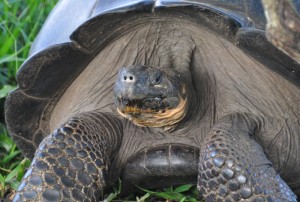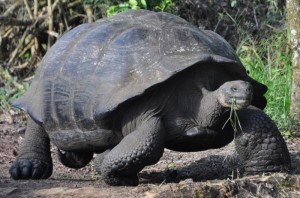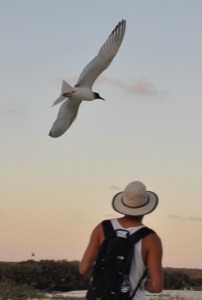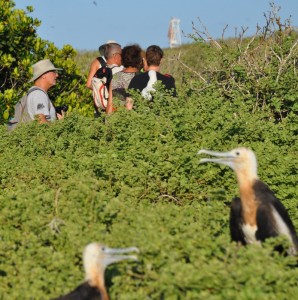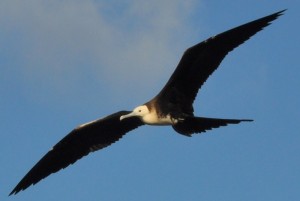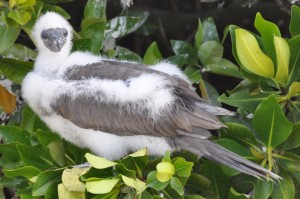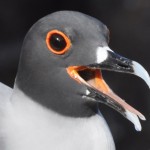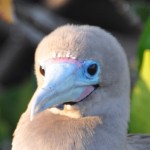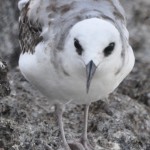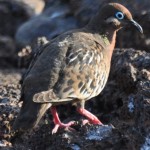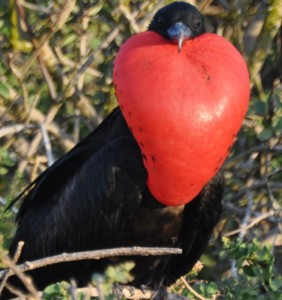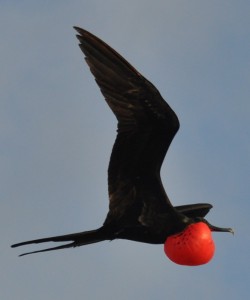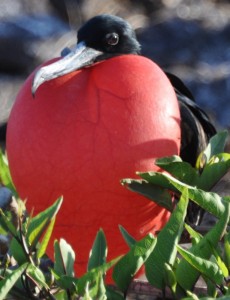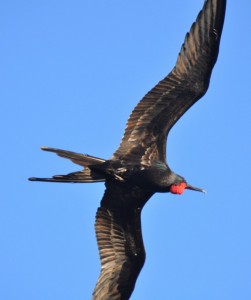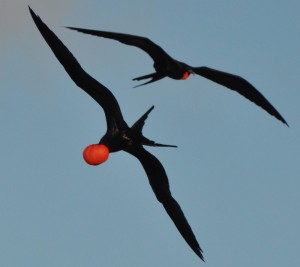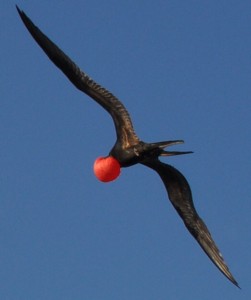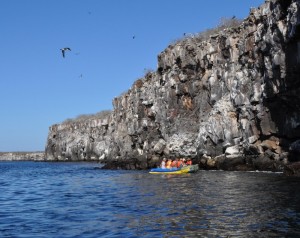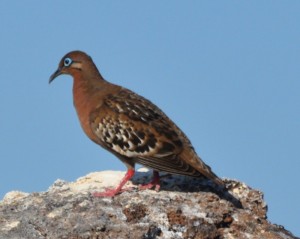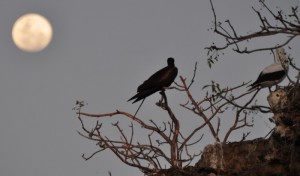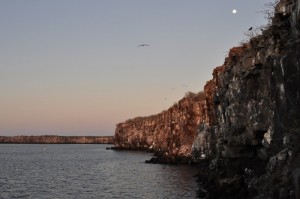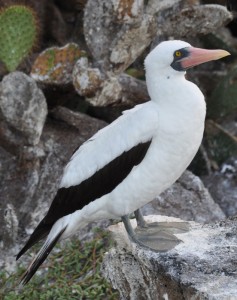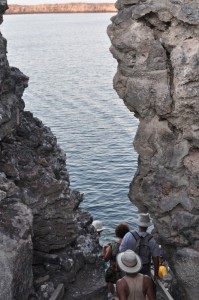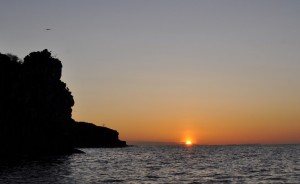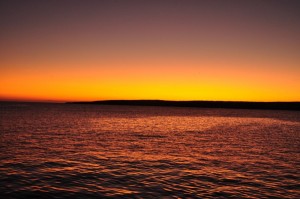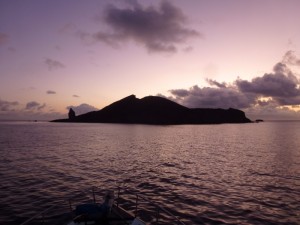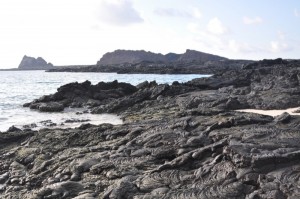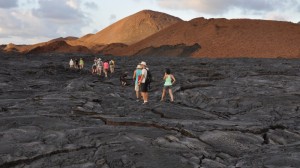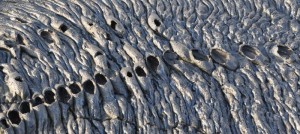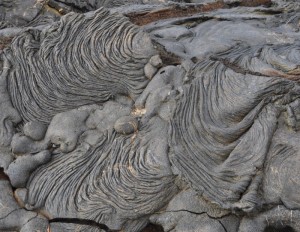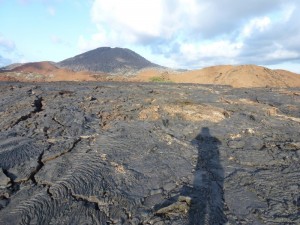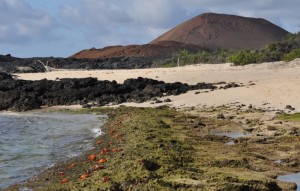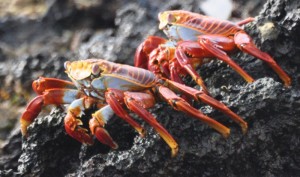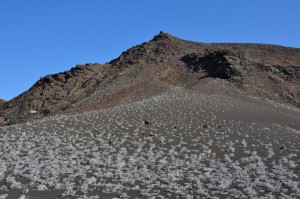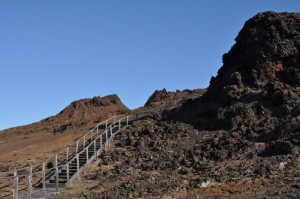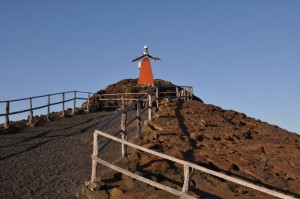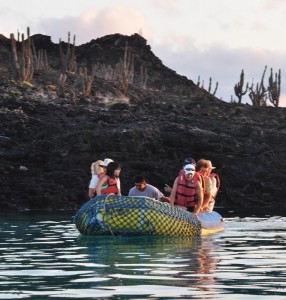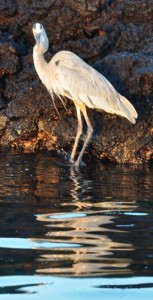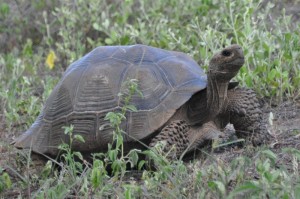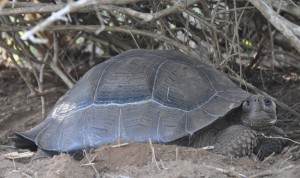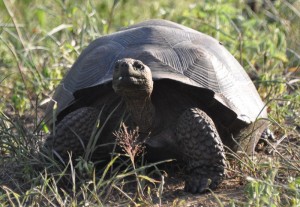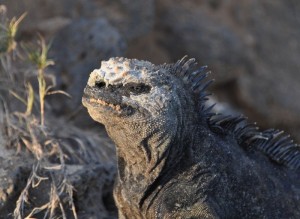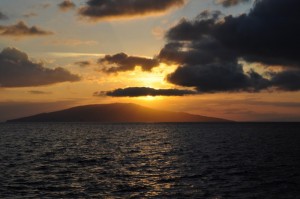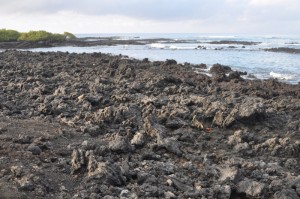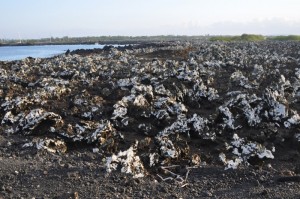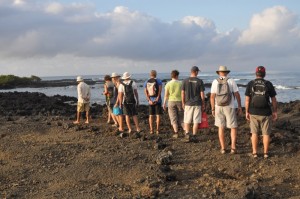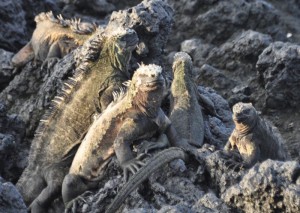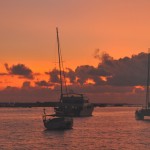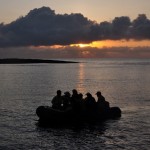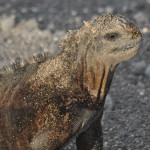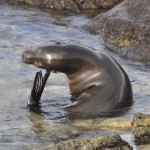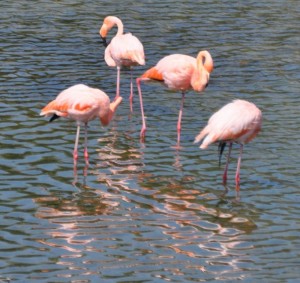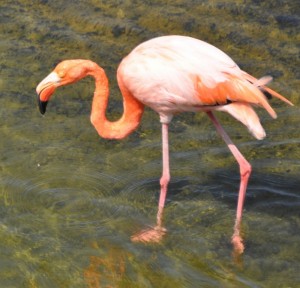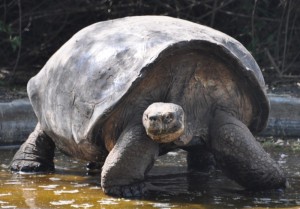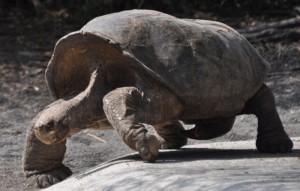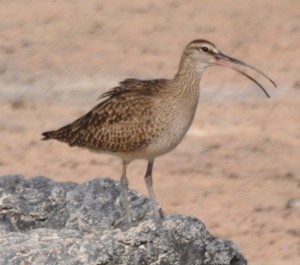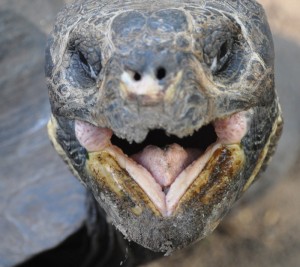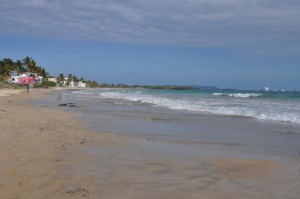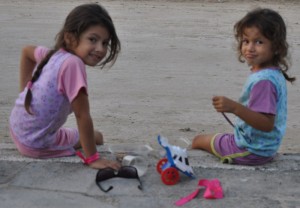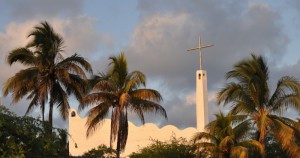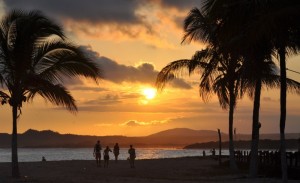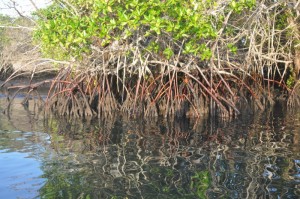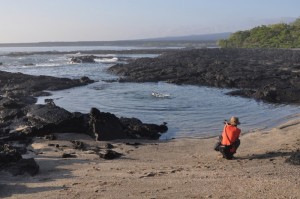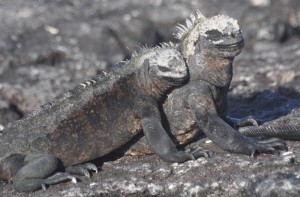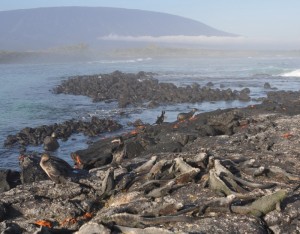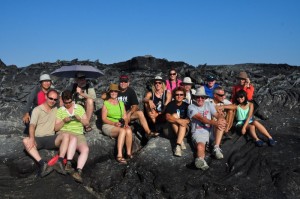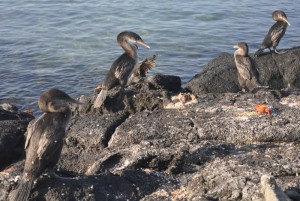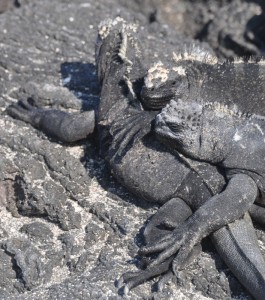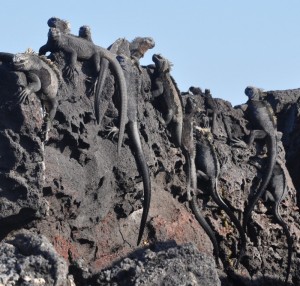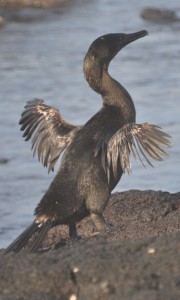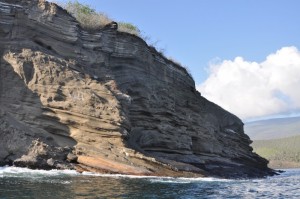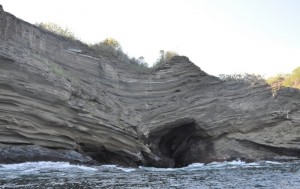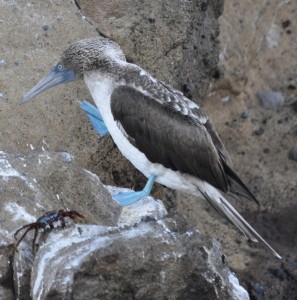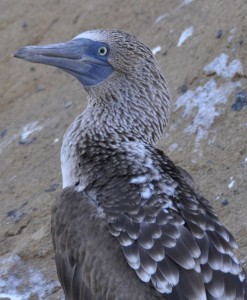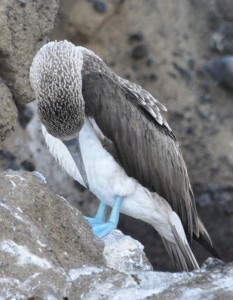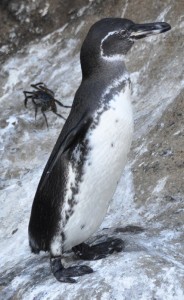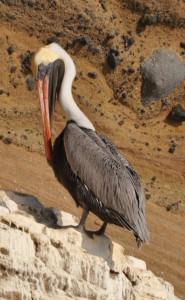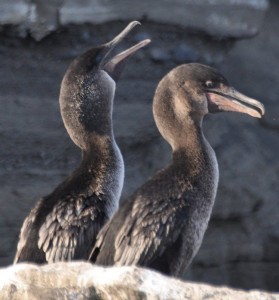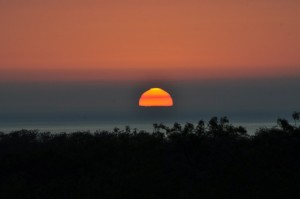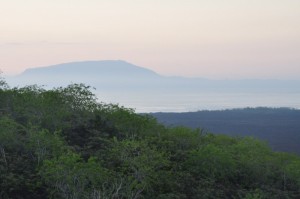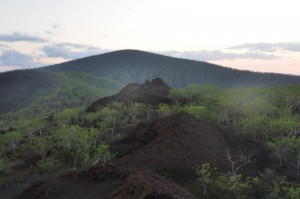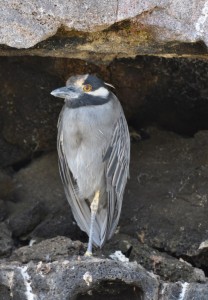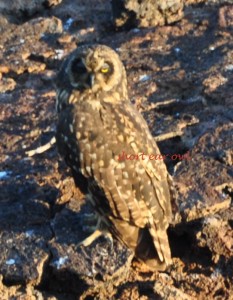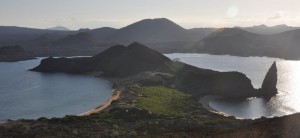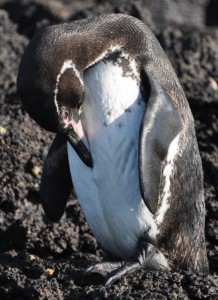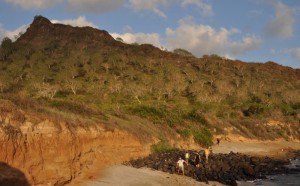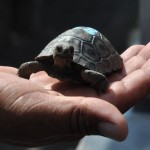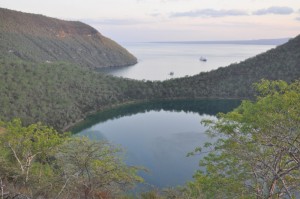March 13-20: 8-day cruise in North Galápagos on Floreana
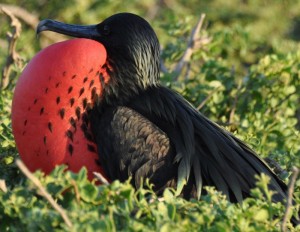 Frigatedbird with a red pouch |
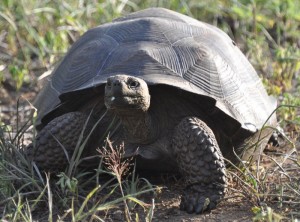 Giant Tortoise from Isla Santa Cruz |
Day 1 – Santa Cruz
At midday, I boarded the Floreana which was mooring at the canal. On my way to the canal, I visited a 1-km long lava tunnel at Bellavista and the Gemelos, two craters by a road side. It is the longest lava tunnel I have visited with part of the roof reaches 10 metres high. It was dark and a bit scary. Luckily there was another tourist who gave me a hand.
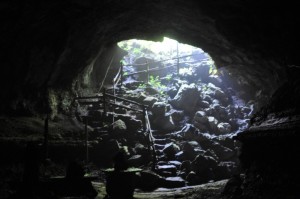 Entrance to a 1km-long lava tunnel |
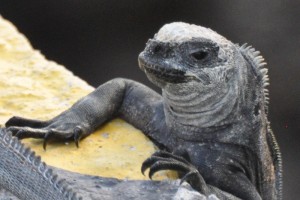 |
|
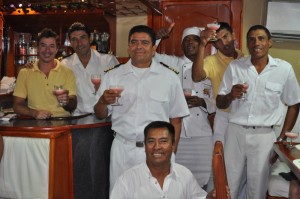
Guide and Crew on Floreana
Floreana with a capacity of 16 passengers is painted in green. The 14 other passengers included six Canadian, five Swiss, a Dutch couple and an Aussie. The oldest person is 64 while the youngest is 24. Each cabin has two bunk beds and a toilet. It is small but livable for a week!
Victor our guide took us to Los Gemelos (the twins) with two 30-metre-deep craters (for the second time in a day) and the El Chato Tortoise Reserve in Santa Rosa, the oldest town on the island. There are over 3,000 tortoises in the reserve. We also saw a lava tube which is not as long as the one I visited in Bellavista. We had dinner at 7pm and a full briefing. I was tired and had an early night.
|
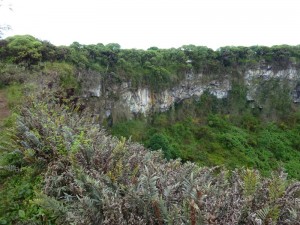 Gemelos |
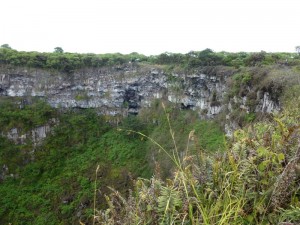 |
Day 2 – Genovesa: 2 excursions & 2 snorkel sessions
Isla Genovesa about 3 million years old is also known as Tower Island or Booby Island. It is a paradise for birds with about 300,000 birds. Early morning is the best time for bird watching. We had our first wet landing on Darwin Bay Beach shortly after 6am.
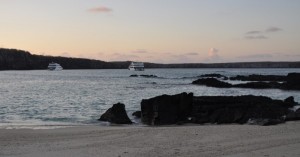 Darwin Bay Beach |
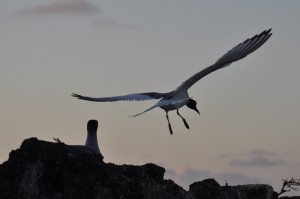 |
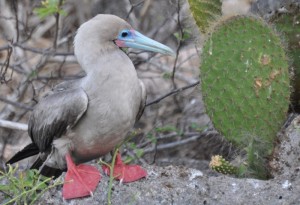 Red-footed booby |
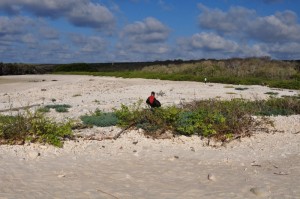 |
|
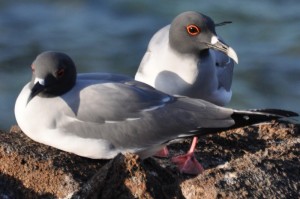 Galapagos doves |
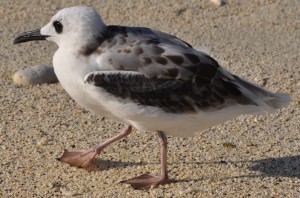 |
I was greeted by hundreds of frigatebirds with long narrow and pointed wings that span up to 2m and a long forked tail. Males had balloon-like red throat pouches inflated during courtship displays. There are numerous nasca boobies with a stout yellow-orange bill and a blue-black face mask and red-footed boobies. I also saw many swallowed-tailed gulls, Andean gulls, lava gulls, yellow-crowned night herons, mockingbirds, brown pelicans, tropicalbirds, doves and Darwin finches. There are countless nests of red-footed boobies and frigatebirds and their chicks.
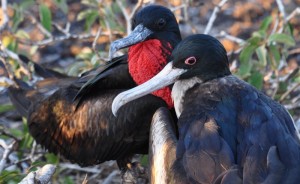 |
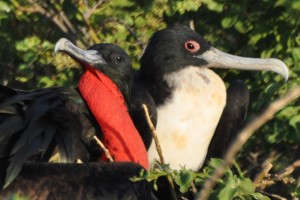 Male (L) & female (R) |
We returned to the boat and had our first breakfast with five types of cut fruits, toasts and eggs. At 10am, we snorkeled near the Darwin Bay beach. The first snorkel was a disappointment as the water was muggy. The only surprise was the sighting of a hammerhead shark when we first got into the water. I thought I saw another one before leaving the water.
Lunch was served at noon followed by siesta. At 2pm, we were off for the second snorkel on the eastern shore. Visibility was much better and I saw more fish. But it is nothing compared with the coral fish at Great Barrier Reef in Australia.
We had a second excursion at 4pm. This time, we landed at the tip of Darwin Bay’s eastern arm and climbed a steep-railed stairway to the top of the cliff. Birds were returning from the sea to feed their chicks. Here the trees are mostly leafless. We spotted two short-eared owls.
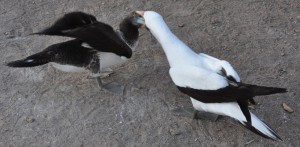 Nazca booby feeding its chick |
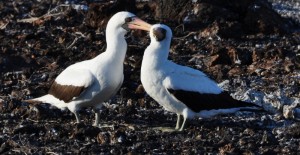 A pair of Nazca boobies |
We quickly settled in our daily routine: first excursion at 6am; snorkel at 10am; lunch at noon, snorkel at 2pm, second excursion at 4pm and dinner at 7pm followed by briefing on activities for the following day. Time vanished quickly on the boat and I slept well throughout the cruise.
Day 3 – Santiago: 2 excursions & 2 snorkel sessions

Isla Santiago is the fourth largest island where federal goats have been eradicated since 2006. The famous Pinnacle Rock on Isla Bartolomé is the most photographed site in Galápagos. An eruptions in 1897 has created the Sullivan Bay where we landed at 6am. The black lava in all forms and shape look artistic due to its almost ceramic feel. The 1.5-km lava trail is scenic. I took plenty photos of the Sally Light-footed crabs on the beach.
During the morning snorkel, I saw the first white-tipped shark of this trip. The water was clear and the snorkel was more enjoyable. A school of Galápagos penguins swam past me: it was wonderful to watch them swimming and diving underwater. In the afternoon, I saw more white-tipped sharks, half a dozen of Galapagos penguins in the water and several manta and eagle rays.
At 4pm we set off for a pleasant walk on Isla Bartolomé (about 1.5 million years old) with numerous small craters. A wooden staircase takes visitors to the summit (114m). The island though looks barren on first sight has grey vegetation on its dark brown steep slopes. There are also lots of green scrubs in the sandy beach close to the Pinnacle Rock. Panoramic view of Isla Santiago in the morning light would be gorgeous and photogenic. But an afternoon visit does not afford me a chance for taking a postcard photo. On the way back to the boat, we saw many dolphins and had a fun ride in our dingy.
Our boat moored off Sombrero Chino (Chinese Hat), a tiny island off the southeast tip of Isla Santiago. The sun was setting while the moon started to glow on the opposite side. I had a good sleep as the boat was not moving and there was no engineer noise.

Isla Sombrero Chino at sunset
Day 4 – Sombrero Chino & Santa Cruz: 2 excursions & 1 snorkel session
We had our 6am-hike on Isla Sombrero Chino. The water between this island and Isla Santiago is shallow with a white sandy bottom. I saw a couple of white-tipped sharks, several rays, penguins and sea lions from the boat. Dropped off at a sandy beach, we were welcomed by three brown pelicans and a couple of sea lions. There were dozens of sea lions and iguanas basking in the sun.
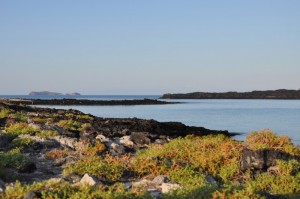 |
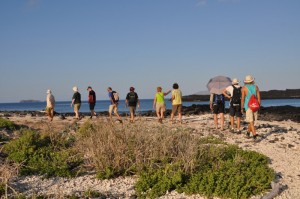 |
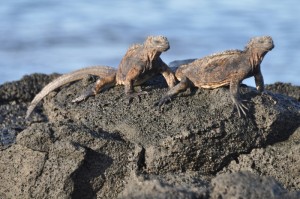 Marine iguana |
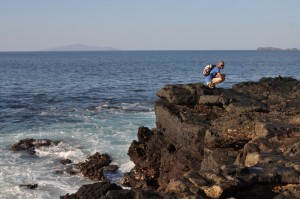 Nick watching the iguanas |
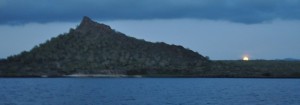
Moon rise before sunset
During the morning snorkel, I saw a couple of manta rays and swam with a big sea lion. I found a lonesome baby sea lion in a small sea cave and played with it for a while. The water was nice and warm.
The boat moved to the western side of Isla Santa Cruz and we had a walk at Whales Bay at 4pm. Victor said that 35 tortoises were released here seven years ago.
We were lucky to spot eight tortoises. A few were crossing the trail and posing for us!
Day 5: Isabela: 2 land excursions & 1 snorkel session
Landscape of Isla Isabela is dominated by six intermittently active volcanoes. Volcano Wolf in the north is the highest at 1646m while Volcano Sierra Negra in the southwest boasts the second largest active volcano in the world.
At 6am, we set foot on Las Tintoreras named after the reef sharks that frequent them. This small islet is barren with mangroves at its fringe. But greyish lichens grows on the rocks softening the stark landscape. Thousands of black marine iguanas basking in the sun blend in well with the black lava. Some blue-footed boobies were resting on the rocks.
At 10am, we snorkeled in the shallow water off Isla Isabela and saw a dozen of rays. I spotted a giant green ray and two sharks. A sea lion came up to me and we played for a while. This is the best snorkel I had so far on this trip.
At 2pm, we landed at Puerto Villamil, a small laid-back town with a population of about 2,000. On the way to the breeding centre for tortoises, we saw a dozen of Greater Flamingos and stilts. This breeding centre seems better organized. Eggs are taken here and incubated. Sex of a tortoise is determined by the temperature during incubation: 28ᴼC for males and 29ᴼC for females. Young tortoises are kept in these boxes for the first two years and then put in separate pans for another five years before releasing them in the wild.
We returned to the town on foot. I had a 2-hour rest drinking beer and having ice-cream as it was so hot! I also emailed my friends.
Day 6- Fernandina (1excursion & 1 snorkel session) & Isabela (1 sea excursion, 1 excursion &1 snorkel session)
Today, we set foot on Punta Espinosa, the only spot for visitors to Isla Fernandina, the youngest (about one million years old) and most volcanically active island in the group. It has the largest colony of marine iguanas in the archipelago (300,000) and a large population of flightless cormorants. I also saw a couple of yellow warblers.
At 10am, we snorkeled close to the shore of Fernandina. The water is very cold and unpleasant. But I saw for the first time marine iguanas feeding on green algae underwater. They can stay underwater for over an hour. The water was so cold that I returned to the dingy after a while. But when I heard a shout ‘turtle here’, I jumped into the water and joined the crowd watching a giant green turtle by a rock for 15 minutes. It is miracle to see this beautiful creature underwater. Victor said the turtle might be 50-80 years old.
After a nice lunch, I watched sea turtles and penguins from the deck for an hour.
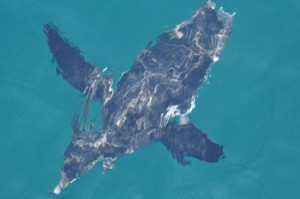 Playful Galapagos penguin by our boat |
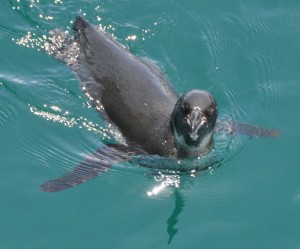 |
Then we were in the water again (this time on Isla Isabela side). The water is much warmer. Unfortunately, dozens of tourists on board a large cruise ship with over 100 passengers were also snorkeling in the same area. I bumped into them a couple times. They were making lots of noises and made a fuss in the water. It was not fun and I did not stay in the water for too long.
After snorkel, the group of +100 moved to Tagus Cove on Isla Isabela. Victor decided to delay our 4pm-walk so that we could avoid the group. He arranged a dingy excursion along Canal Bolívar to watch wildlife. I saw a hawk, many blue-footed boobies on the cliffs, brown pelicans, penguins and sea lions. The coast line with colourful layers of soil and rocks is magnificent.
At 5:30pm, we set foot on Tagus Cove where whales and visitors had left their marks behind. The rocks are covered in graffiti with the oldest one from whalers dating from 1836. We followed the 2-km trail passing by the 12-m-deep crater-lake named after Charles Darwin before arriving at a lava slope of Darwin Volcano. View over the entire Isla Isabela is spectacular. We watched a gorgeous sunset before rushing back to the boat. It was 6:45pm when I had a beer on the deck. I watched an orange full moon rising at 8pm. Romantic!


